
|
What is Bacon? |
|---|
Bacon, a highly seductive meat, originates from a cut of pork from either the side, belly, or back of the pig. These portions of the pig's anatomy have layers of fat and muscle intertwined; slices, cut as a cross-section, reveal bacon's alternating lean and fatty character.
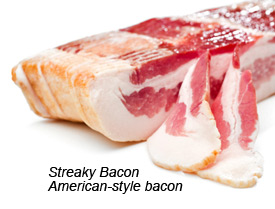 Bacon - Made Salty and Smoky - A dietary staple for centuries, bacon is still salt-cured. The curing is an essential process for the pork's preservation where freshly cut slabs are soaked in a brine, or dry-cured by packing in salt. Salt curing makes the environment inhospitable for bacteria that would otherwise spoil the meat. Today's salt-curing processes use less salt than in the past, and place greater reliance on packaging and refrigeration. Smoking bacon also originated as a method for preservation. Smoking may occur at low temperatures or high temperatures. Bacon is optionally smoked, but all bacon is salt-cured. Bacon - Made Salty and Smoky - A dietary staple for centuries, bacon is still salt-cured. The curing is an essential process for the pork's preservation where freshly cut slabs are soaked in a brine, or dry-cured by packing in salt. Salt curing makes the environment inhospitable for bacteria that would otherwise spoil the meat. Today's salt-curing processes use less salt than in the past, and place greater reliance on packaging and refrigeration. Smoking bacon also originated as a method for preservation. Smoking may occur at low temperatures or high temperatures. Bacon is optionally smoked, but all bacon is salt-cured.Types of Bacon - Bacon comes in several different forms based on the cut of pork, type of salt curing, optional smoking, and different aging techniques. Here are some common bacon terms: Streaky Bacon - A term for bacon made from pork belly and most commonly thought of as common, American-style bacon; the slices have alternating "streaks" of lean and fat.
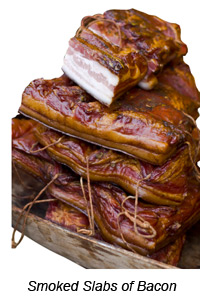 Slab Bacon - Unsliced, a slab of bacon is a solid chunk and often has the rind still present on one side. A slab of bacon is a useful purchase when a small dice or chunks of bacon are desired for a recipe. Slab Bacon - Unsliced, a slab of bacon is a solid chunk and often has the rind still present on one side. A slab of bacon is a useful purchase when a small dice or chunks of bacon are desired for a recipe. Canadian Bacon - This style of bacon uses the much leaner, loin portion of the pig's back. Canadian bacon is cured, smoked, and fully cooked. In many respects, it has a character closer to ham than bacon. Rasher - Rasher is another word for a slice of bacon and is a term more frequently used in the UK. Pancetta - Italian in origin, pancetta is unsmoked pork belly cured with salt and spices, then aged for about 12 weeks. The meat is often rolled, and is typically sliced very thinly. Prosciutto - Also Italian in origin, prosciutto is actually a ham that is dry-cured and aged. It is served, uncooked, in very thin slices. Speck - Another pork product from Italy and Austria, speck is salt-cured, smoked, and very highly seasoned. It, too, is served in very thin slices. Guanciale - This form of bacon is made from pork jowl. It is a dry-cured Italian meat that is gaining in popularity. 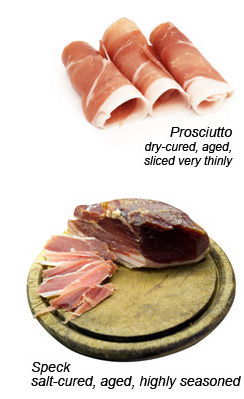 Trends in Artisanal Bacon - Bacon has experienced a renaissance in popularity occasionally reaching cult status. Differences in bacon start with the breed of the pig and what the pig is fed during its growth period. For example, a pig fed a diet with acorns produces a meat described as "creamy." The meat may be processed with different types of salts possessing unique qualities. Different woods used in smoking produce different flavors in the bacon. The most popular smoking woods for bacon are hickory and applewood. Some bacon features brown sugar or maple syrup for added sweetness. Trends in Artisanal Bacon - Bacon has experienced a renaissance in popularity occasionally reaching cult status. Differences in bacon start with the breed of the pig and what the pig is fed during its growth period. For example, a pig fed a diet with acorns produces a meat described as "creamy." The meat may be processed with different types of salts possessing unique qualities. Different woods used in smoking produce different flavors in the bacon. The most popular smoking woods for bacon are hickory and applewood. Some bacon features brown sugar or maple syrup for added sweetness.Crazy over Bacon - Devotees of bacon can join "Bacon of the Month" Clubs, or enjoy bacon with its partner, mayonnaise as "baconnaise." Bacon has long been enjoyed in a peanut butter sandwich, and now commonly finds itself paired with chocolate. The truly bewitched can obtain bacon-flavored jellybeans, bacon band-aids, bacon dental floss, and even bacon air freshener. The Skinny on Bacon Fat - Surprisingly, bacon has less saturated fat per gram of fat than butter. But, let's face it, bacon is not a health food. A steady diet of bacon would not please our health care team. But, in MODERATION, bacon may have a role at our tables. For example, bacon crumbles add a lot to a dish as a flavor accent and allows us full flavor and moderation at the same time. |
Preparing Perfect Bacon |
|---|
We've outsourced a lot of bacon preparation to the convenience of pre-cooked bacon, pre-crumbled bits, or bacon-topped fast-food burgers, all in the name of reducing the hassle-factor. However, in this pursuit of fast and easy, we've lost a huge amount of flavor in the translation. Freshly made bacon is delicious! Here's how: 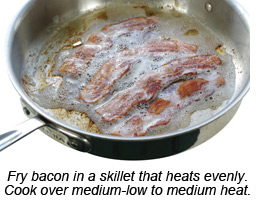 Frying - When cooking just a few strips of bacon, frying is quick and easy. Place the bacon slices in a cold skillet and apply medium-low to medium heat. Beginning with a cold skillet allows some of the bacon's fat to liquefy and reduces sticking. Turn the bacon while frying and move to different sections of the skillet to evenly cook the slices. Pan-frying will take about 12-15 minutes depending the thickness of the bacon. The best advice for pan-frying bacon is to keep the heat low and watch carefully. Drain cooked slices on a plate lined with paper towels. Blot the strips with a paper towel to remove any excess bacon fat. Frying - When cooking just a few strips of bacon, frying is quick and easy. Place the bacon slices in a cold skillet and apply medium-low to medium heat. Beginning with a cold skillet allows some of the bacon's fat to liquefy and reduces sticking. Turn the bacon while frying and move to different sections of the skillet to evenly cook the slices. Pan-frying will take about 12-15 minutes depending the thickness of the bacon. The best advice for pan-frying bacon is to keep the heat low and watch carefully. Drain cooked slices on a plate lined with paper towels. Blot the strips with a paper towel to remove any excess bacon fat.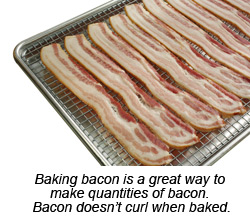 Baking - An increasingly popular method for cooking bacon, baking is a great method for cooking an entire pound or more of bacon. Line a jellyroll pan (20" x 14"), or any baking pan with an adequate rim, with aluminum foil. Place the bacon strips in a single layer and place in a cold oven. Turn the oven on to 400°F and bake for 12-17 minutes. Baking time will vary based on the thickness of the slices. Transfer baked slices to a plate lined with paper towels. Blot excess fat away with a paper towel. Alternately, bake bacon on a rack inserted into the jellyroll pan to drain the fat away during baking. Baking - An increasingly popular method for cooking bacon, baking is a great method for cooking an entire pound or more of bacon. Line a jellyroll pan (20" x 14"), or any baking pan with an adequate rim, with aluminum foil. Place the bacon strips in a single layer and place in a cold oven. Turn the oven on to 400°F and bake for 12-17 minutes. Baking time will vary based on the thickness of the slices. Transfer baked slices to a plate lined with paper towels. Blot excess fat away with a paper towel. Alternately, bake bacon on a rack inserted into the jellyroll pan to drain the fat away during baking.Broiling - This method cooks from the top down. Preheat the broiler and place the oven's rack so that the bacon is about 3 inches from the heat source. Place the bacon on a broiling rack that lies inside a catch pan. Broil the bacon for about 6-7 minutes depending on the thickness of the bacon slices. 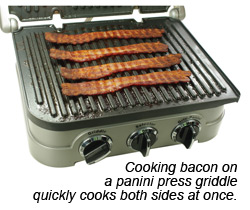 Panini Griddle - A panini griddle or any grill press cooks bacon quickly from both the top and the bottom keeping the bacon flat while cooking. Place the bacon on the bottom half of a cold griddle. Set the dial on medium heat and lower the top griddle. The grilling bacon will produce a prodigious amount of grease - make sure to have an adequate grease catcher at the grill's drain point. Panini Griddle - A panini griddle or any grill press cooks bacon quickly from both the top and the bottom keeping the bacon flat while cooking. Place the bacon on the bottom half of a cold griddle. Set the dial on medium heat and lower the top griddle. The grilling bacon will produce a prodigious amount of grease - make sure to have an adequate grease catcher at the grill's drain point.Deep Frying - As long as bacon is on the menu, doubling-down with deep-frying it seems only a small step further down the decadence pathway. Coat thin slices of bacon in flour, or a light tempura-like batter, and fry in a skillet with a quarter to half-inch of oil. 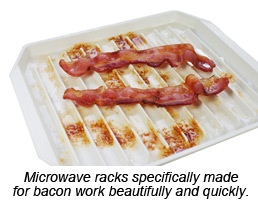 Microwaving - On a microwave-safe plate lined with paper towels, place the bacon strips. Cover the strips with a single layer of paper towels to reduce spattering. Microwave on high for 5-7 minutes turning the plate a quarter turn halfway through the cooking if not on an automatic turntable. Try microwave safe bacon racks designed to drain fat while cooking. Microwaving - On a microwave-safe plate lined with paper towels, place the bacon strips. Cover the strips with a single layer of paper towels to reduce spattering. Microwave on high for 5-7 minutes turning the plate a quarter turn halfway through the cooking if not on an automatic turntable. Try microwave safe bacon racks designed to drain fat while cooking.Storing Bacon - Store bacon in the colder section of the refrigerator. Check the packaging for the "Best Used By Date." Once opened, the bacon should be used within a week. Uncooked bacon may be frozen with best results when used within a month. |
|